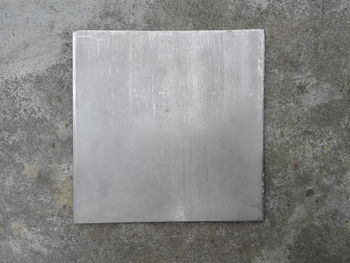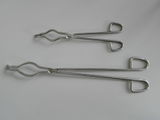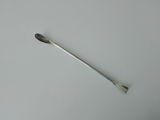Difference between revisions of "Stainless steel"
| Line 3: | Line 3: | ||
'''Stainless steel''', also known as '''inox steel''' or '''inox''' in some countries, is a common [[steel]] alloy with a minimum of 10.5% [[chromium]] content by mass, widely used in construction and every day objects. | '''Stainless steel''', also known as '''inox steel''' or '''inox''' in some countries, is a common [[steel]] alloy with a minimum of 10.5% [[chromium]] content by mass, widely used in construction and every day objects. | ||
| − | Stainless steel is sometimes shorted to '''SS''', though this abbreviation is not commonly accepted. | + | Stainless steel is sometimes shorted to '''SS''', though this abbreviation is not commonly accepted. Other names for stainless steel are '''corrosion-resistant steel''' ('''CRES''') or '''rustless steel'''. |
==Composition== | ==Composition== | ||
Latest revision as of 08:52, 23 September 2023
 |
This article is a stub. Please help Sciencemadness Wiki by expanding it, adding pictures, and improving existing text.
|
Stainless steel, also known as inox steel or inox in some countries, is a common steel alloy with a minimum of 10.5% chromium content by mass, widely used in construction and every day objects.
Stainless steel is sometimes shorted to SS, though this abbreviation is not commonly accepted. Other names for stainless steel are corrosion-resistant steel (CRES) or rustless steel.
Contents
Composition
Stainless steel contains between 10.5-26 % chromium, while some types can also have nickel.
Stainless steel alloys can be classified by their crystalline structure, as austenitic, ferritic, martensitic, duplex steel and precipitation-hardening martensitic.
Properties
Physical
Stainless steel is a lustrous silvery metallic alloy, which is resistant to corrosion and does not rust in air. The density of stainless steel is between 7.48 - 8.05 g/cm3, SS in general being slightly denser than the more common carbon steel. Stainless steel is a relative poor electrical conductor. Annealed austenitic stainless steels are non-magnetic, while ferritic and martensitic stainless steels are magnetic. However, work hardening is known to make austenitic stainless steels slightly magnetic. The melting range of stainless steel is between 1325 to 1530 °C, with 1510 °C being the most often used value.
Chemical
Stainless steel is very resistant to most reagents, though its resistance varies depending on the grade. Types 316 and 317 are immune to all organic acids, and are widely used to store and transport acetic acid, and can also resist sulfuric acid with a concentration below 10%. However, type 304 is not resistant to sulfuric acid at any concentration, while Type 904 shows good resistance to sulfuric acid at room temperature even at high concentration. Phosphoric acid does not attack stainless steel to any noticeable effect. While nitric acid attacks most SS alloys, types 304L and 430 have shown to be more resistant. On the other hand, hydrohalic acids, such as hydrochloric acid will attack all types of stainless steel, moreso in the presence of oxygen. Halogens will also corrode stainless steel, though the effect differs from alloy to alloy. All stainless steels resist molten alkali hydroxides, which makes them suitable for reaction vessels where molten alkali is required, though in presence of air, the corrosive effect of the molten alkali increases. However, presence of chloride ions in the alkali will decrease their chemical resistance, which makes SS unsuitable for handling hypochlorite solutions (aka bleach). Ammonia does not affect stainless steel. Mercury and molten gallium will not attack stainless steel.
Availability
Stainless steel can be found in a variety of every day objects, such as kitchen utensils (cups, plates, pots, cutlery, sponge, sieve, etc.), electronics (screws, nuts, coverings, etc.), tools (scissors, knives, tweezers, razors, etc.), plumbing (pipes, taps, connectors, etc.) old machine parts and many other objects.
Occasionally one may find discarded stainless steel strips near utility poles, where they're used to hold various electrical-related items to the said pole. Some SS strips may be magnetic, which may be due to low chromium content or high nickel content (or both).
Stainless steel can also be purchased as bars from various metal suppliers.
Preparation
It's not very cheap to make stainless steel from scratch, and it's cheaper to simply purchase it from shops or scavenge it from various OTC products.
Projects
Stainless steel is useful as building material for various projects, due to its good chemical resistance, good mechanical properties and isn't magnetic. However, stainless steel welding is a bit more complex than carbon steel welding. Electric arc welding is usually employed, while gas welding gives poorer bonding.
- Crucible for various reactions
- Make chromates and dichromates
- Make chromium(III) sulfate
- Filtering liquids (sieve/mesh)
- Store various reagents and labware (stainless steel container)
Handling
Safety
Stainless steels are inert and consuming food or liquids from food-grade stainless steel objects is safe. Some SS types may contain nickel which is irritant.
While stainless steel doesn't rust easily in air, it will suffer from pitting corrosion, which may lead to the perforation of the stainless steel object if it's too thin, causing the content of the SS container to leak.
Storage
Stainless steel objects should be kept away from hydrohalic acids and halogens. Periodically inspect SS objects for any signs of pitting corrosion.
Disposal
Stainless steel is best recycled or taken to metal recycling centers.
Gallery
Crucible tongs made of stainless steel


